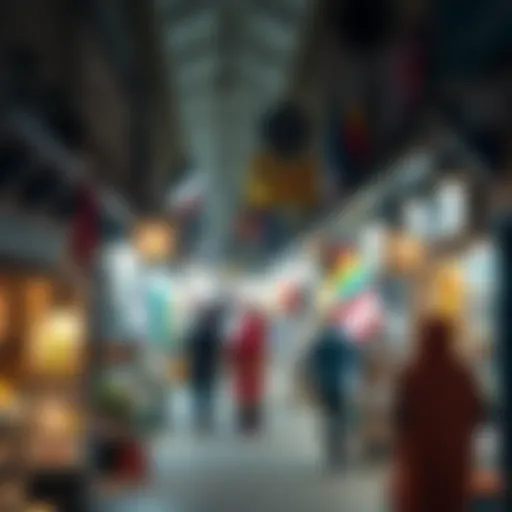Top Restaurant Interior Design Firms in Dubai
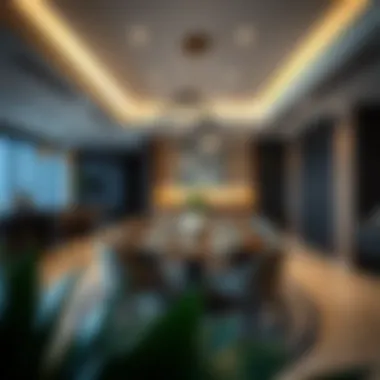
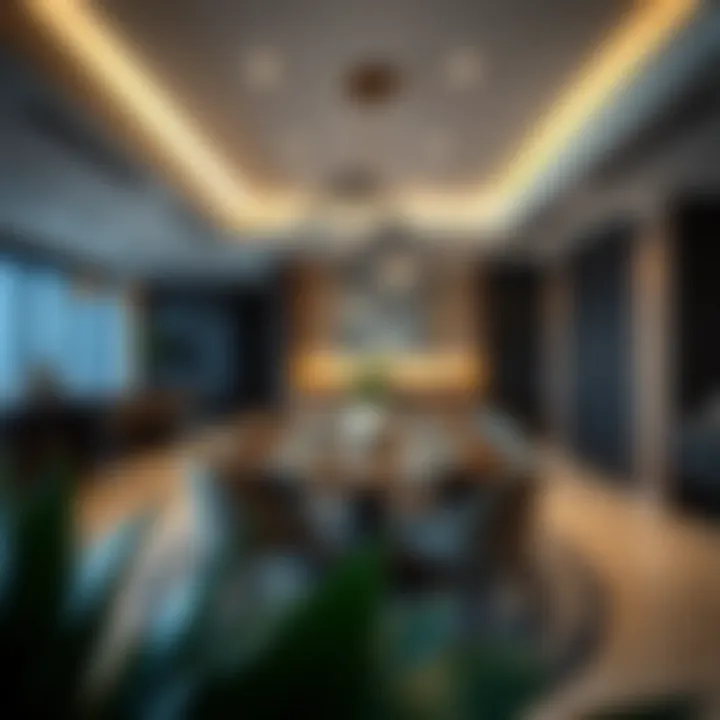
Intro
Dubai, a city that's both a melting pot of cultures and a hotspot for innovation, carries a unique flair in its restaurant industry. Dining is not simply about food here; it's an experience wrapped in aesthetic pleasure and functionality. As the competition grows, so does the need for exceptional interior design—to create an atmosphere that speaks to patrons and draws them in. This article sets out to unravel how restaurant interior design companies in Dubai are shaping this vibrant scene.
From the bustling markets of Deira to the trendy spots in Downtown, these spaces embody visions that fuse tradition with modernity. Visitors and residents alike are seeking more than just a meal; they're craving settings that evoke emotions, stories, and a sense of community. With this in mind, let’s lend our ears to those who guide these creations—the interior design companies.
In this exploration, we’ll examine key players in the market, delve into current trends impacting design decisions, and offer insights for anyone looking to invest in this dynamic environment. Understanding the nuances of restaurant design in Dubai could just be the ticket you need to stand out in a saturated market.
Foreword to Restaurant Interior Design in Dubai
In a city as vibrant and diverse as Dubai, the role of restaurant interior design cannot be underestimated. As dining spots multiply and the competition ramps up, creating an inviting ambiance becomes essential. This introduction strives to unpack the nuances of restaurant interior design, illustrating its vital significance in shaping culinary experiences. Here in Dubai, where tradition meets avant-garde innovation, the design serves as a key player in attracting clientele and differentiating businesses.
Defining Restaurant Interior Design
Restaurant interior design refers to the comprehensive planning and execution of space within a dining venue. It encompasses elements such as layout, color schemes, lighting, materials, and furnishings. It's not just about aesthetics; it’s the coordination of these components that fosters a certain atmosphere and functional flow. When diners enter a restaurant, the first impression is largely dictated by its interior. Good design should evoke emotions that align with the restaurant's overall theme or cuisine. For instance, a family-friendly Italian eatery might lean towards warm colors and cozy seating, whereas a high-end sushi restaurant could opt for minimalist decor with clean lines and subdued tones. Each of these choices communicates a message to potential customers.
The Importance of Interior Design in the Culinary Space
The culinary space is a battleground for capturing both the eyes and the appetites of patrons. Interior design holds the power to enhance the dining experience, impacting customers' perceptions and behavior. Consider it this way: if the environment feels bland or uninviting, diners may not linger over their meals, leading to missed opportunities for upselling or turning table turnover rates. On the flip side, a thoughtfully designed space can nurture a sense of comfort and enjoyment, prompting longer stays and repeat visits.
"A restaurant's design is a silent ambassador, speaking volumes about its brand and its attention to detail."
Moreover, design pulls double duty by reinforcing marketing messages—whether through thematic decor or strategic layout that encourages social interactions. When patrons feel a connection with their surroundings, they’re more inclined to share their experiences online, amplifying the restaurant's visibility and appeal.
Overview of the Interior Design Market in Dubai
Understanding the interior design market in Dubai is crucial not only for design enthusiasts but equally for investors, real estate agents, and developers. The city has become a melting pot of cultures and styles, shaping a unique landscape where tradition intertwines with innovation. This dynamic environment creates a vibrant market, reflecting the diverse clientele and their varying tastes, making it imperative for anyone involved in restaurant design to grasp this complexity.
Current Trends in Interior Design
In recent years, Dubai has grown into an epicenter for bold and innovative design choices, particularly in the restaurant sector. Among the current trends shaping this market are:
- Sustainable Practices: With a growing awareness of global climate issues, many designers are now prioritizing eco-friendly materials and designs. Restaurants are opting for reclaimed wood, recycled metals, and energy-efficient lighting to reduce their carbon footprint.
- Cultural Blends: Many eateries are embracing a fusion of styles, drawing heavily on Dubai’s rich heritage while integrating contemporary aesthetics. This approach helps in creating a familiar yet refreshing ambiance that resonates with locals and tourists alike.
- Biophilic Design: Incorporating natural elements into interior spaces is trending in Dubai. Designers are integrating indoor gardens, natural light, and water features to create serene dining environments, effectively bridging the gap between the indoors and outdoors.
These trends not only reflect current consumer preferences but also align with the city’s goals of establishing itself as a global hub for architecture and design.
Notable Projects and Designs
An examination of iconic restaurant designs in Dubai underscores the innovative spirit prevalent in the city's interior design market. Noteworthy projects include:
- Zuma Dubai: A well-known institution, Zuma showcases contemporary Japanese izakaya cuisine in a modern yet comfortable setting. The creative use of dim lighting and understated elegance reflects the essence of Japanese design while incorporating Middle Eastern elements.
- Coya Dubai: This Peruvian restaurant pushes the envelope with its bold color schemes and intricate design details. The vibrant art and carefully selected decor elements encapsulate the lively spirit of its cuisine, merging cultural richness with a modern restaurant experience.
"Design is more than just aesthetics; it's about creating an experience that resonates with the diner."
- Ravi Restaurant: A beloved local favorite, this establishment demonstrates how traditional design can thrive in a rapidly modernizing city. Its simplicity speaks to the culinary offerings, creating an authentic atmosphere that has stood the test of time.
Each of these projects illustrates how thoughtful interior design not only enhances dining experiences but also builds a unique narrative that engages customers on multiple levels. As Dubai continues to evolve, the interior design market remains a testament to its cultural tapestry, offering varied culinary experiences wrapped in stylistic brilliance.
Key Players in Restaurant Interior Design
In a bustling city like Dubai, where culinary experiences are paramount, the role of restaurant interior design cannot be understated. The right design transforms a mere dining space into an immersive experience, drawing in customers and leaving lasting impressions. Key players in this arena not only dictate the aesthetic of their projects but also shape the culture of dining itself. Understanding who these players are is crucial for anyone involved in the restaurant industry, be it investors, real estate agents, or market analysts.
Leading Design Companies in Dubai
Dubai's landscape is dotted with premier design companies that have carved a niche in the restaurant sector. These firms blend traditional Middle Eastern influences with contemporary styles, creating spaces that resonate with the diverse clientele that populates the city. For instance, Killa Design is well-known for its innovative use of space and sustainability practices. Their projects often feature natural materials and open layouts, reflecting the rich cultural tapestry of Dubai.
Other notable companies like Design Group pride themselves on bespoke solutions tailored to the specific needs of each restaurant. They collaborate closely with restaurant owners to ensure that the design aligns not just with the food served but also with the overall business concept. This partnership often yields spaces that are both visually stunning and highly functional, maximizing both customer satisfaction and operational efficiency.
- Hizbollah Designs: Specialists in thematic dining experiences, they create unique atmospheres that transport patrons to different worlds.
- Dune Designs: Known for their sleek, modern aesthetics, they often integrate cutting-edge technology into their designs, ensuring a seamless dining experience.
By collaborating with these leading companies, restaurant owners can leverage their expertise to navigate the ever-changing landscape of consumer tastes while also adhering to local regulations and cultural sensitivities.
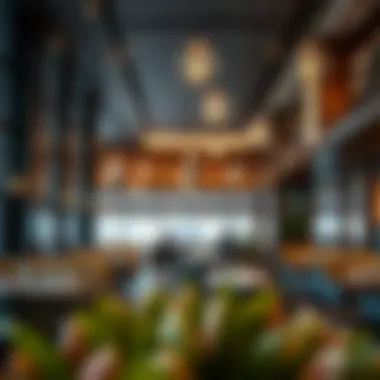
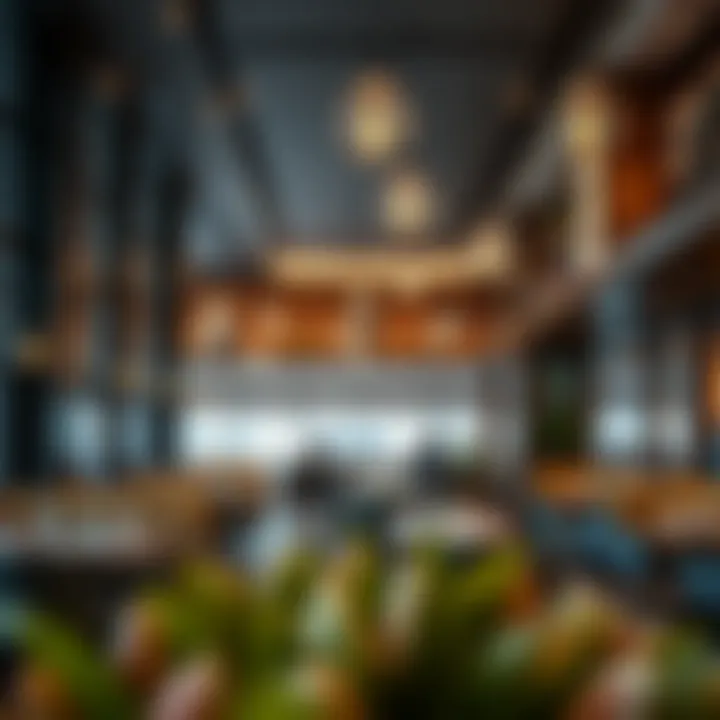
Emerging Talents in the Industry
The design landscape in Dubai isn't solely dominated by established companies. A new wave of talented designers is emerging, bringing fresh ideas and perspectives to restaurant interior design. Many of these emerging designers take inspiration from their travels and experiences abroad, infusing local flavors with international trends.
Nina Tariq, a recent graduate from a prominent design school, has already started making waves with her minimalist approach. Her designs often emphasize the use of light and space, allowing the food to take center stage. This is particularly effective in high-end establishments where the dining experience is about the subtle interplays of flavors and environment.
Another exciting newcomer is Omar El-Guindy, who focuses on sustainable design practices. His projects utilize reclaimed materials and promote eco-friendly solutions, appealing to a growing demographic of environmentally conscious diners. Incorporating these ideas isn't merely a trend; it addresses the rising concern for sustainability in the hospitality industry.
"The success of a restaurant goes beyond the menu; it's about every detail in the space. Emerging designers are redefining what those details can be."
Factors Influencing Restaurant Interior Design Choices
When embarking on a restaurant interior design project in Dubai, it's essential to navigate the myriad of factors that influence design choices. These considerations not only shape the aesthetic appeal of a dining space but also impact its functionality and market success. Understanding these elements allows designers to create environments that resonate with the target audience while adhering to the unique cultural and ecological landscape of the region.
Target Audience and Concept Development
Defining the target audience is paramount in conceptualizing a restaurant. A family-friendly eatery will boast bright colors and playful designs to attract parents with children, while a high-end dining establishment might opt for more muted tones and refined decor to appeal to sophisticated diners.
Understanding who will walk through the door helps in shaping the overall concept. For instance, if the restaurant aims to attract adventurous millennials eager for unique culinary experiences, incorporating an artistic twist can make it stand out.
Creating personas, which are detailed profiles of potential customers, helps in visualizing the restaurant’s clientele. This method includes demographics like age, income, spending habits, and preferences. Once clear personas are established, designers can align the interior with these profiles, ensuring that every design element serves a purpose that aligns with the consumers’ expectations.
Cultural Influences and Local Aesthetics
The rich tapestry of Dubai's culture deeply influences interior design choices. The blending of traditional Arabic motifs with modern design aesthetics creates a unique identity for restaurants. Designers often draw inspiration from local heritage, infusing textiles, colors, and patterns that pay homage to Arabian culture.
For example, incorporating intricate geometric patterns and arabesque designs provides a sense of place that resonates with both locals and tourists. Furthermore, the use of local materials, such as traditional wood or stone, not only supports the aesthetic but also displays a commitment to regional craftsmanship. Understanding and embracing these cultural narratives is critical for a restaurant that wishes to forge a connection with its community.
Sustainability and Eco-Friendly Design
As environmental concerns grow, sustainability isn't just a trend; it's become a fundamental consideration in modern restaurant design. In Dubai, where high temperatures demand innovative cooling solutions, sustainable design includes strategies that utilize local flora and energy-efficient systems.
Designers increasingly focus on sourcing sustainable materials and fostering practices that reduce waste during the construction and operational phases. Energy-efficient lighting, water-saving fixtures, and proper waste management systems can all contribute to a design that aligns with eco-conscious consumer values.
It’s also worth noting how design choices that address sustainability can influence customer perceptions. Diners may be more inclined to support businesses that prioritize environmental responsibility, creating stronger brand loyalty and a more favorable reputation. A positive choice that not only enhances aesthetic appeal but also leaves a lasting impact on the planet.
"Innovative designs that consider both style and sustainability can enhance the dining experience while promoting environmental stewardship."
In summary, the experience of designing a restaurant in Dubai becomes a layered narrative influenced by understanding target audiences, cultural significance, and sustainability efforts. Each decision should circle back to these core elements, ensuring a well-integrated design that is not just visually appealing but also purposeful in today’s dynamic market.
Common Challenges Faced by Designers
The realm of restaurant interior design in Dubai is not merely about aesthetics or craft; it's a delicate dance between creativity and pragmatism. Designers often find themselves navigating a myriad of challenges, each requiring a thoughtful approach. Acknowledging these hurdles is vital for anyone looking to partner with the right design firm or even for those considering a foray into restaurant ownership. By understanding the common challenges that designers face, stakeholders can set appropriate expectations and pave the way for successful collaborations.
Budget Constraints
In the design world, money often talks louder than creativity. Budget constraints can define and dictate the scope of a project. In Dubai, where extravagance is often the standard, striking the right balance between lavishness and cost is essential. Designers might dream big, envisioning walls adorned with exquisite art or bespoke furniture that elevates the dining experience. However, constricted budgets can squeeze these ideas, forcing designers to adjust plans to remain within financial resources.
One effective strategy designers utilize is prioritizing. They assess what elements can be called "must-haves" versus those that are more agreeable. This means focusing on core aspects that would make the biggest impact on diners. For example:
- Lighting: Instead of relying on costly chandelier fixtures, clever use of ambient lighting can create the desired atmosphere without breaking the bank.
- Materials: Selecting locally sourced or alternative materials can often provide both uniqueness and cost-efficiency.
- Furniture: Investing in versatile furniture designed to be easily reconfigured can help achieve a fresh look without a major expense.
Ultimately, it's vital for designers and their clients to engage in open discussions about finances from the get-go. As the saying goes, "A penny saved is a penny earned." Being upfront about what can be realistically achieved with the available budget often leads to better designs and happier clients.
Navigating Regulations and Permits
Operating in a city as dynamic and diverse as Dubai comes with its own set of regulations and protocols, particularly within the various zones of the metropolis. Understanding and navigating these regulatory frameworks can be quite the feat for designers. There are multiple layers of compliance requirements that stem from municipal laws, health and safety standards, and zoning regulations.
For instance, the Health Authority Abu Dhabi (HAAD) has stringent codes regarding the design and fitting of restaurants. This includes specifications for kitchen placements, ventilation systems, and even materials that can be used in flooring and wall finishes. Designers have to be meticulous in their approach, often requiring collaboration with local architects or engineers to ensure that every line drawn and every material proposed complies with regulations.
Additionally, obtaining the necessary permits can be a time-consuming process. Delays in approvals can hold up project timelines, ultimately affecting opening schedules and, consequently, business success. It's essential for designers to be aware of:
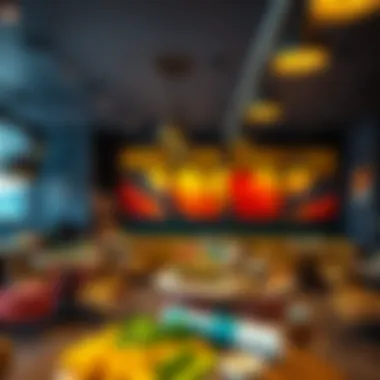
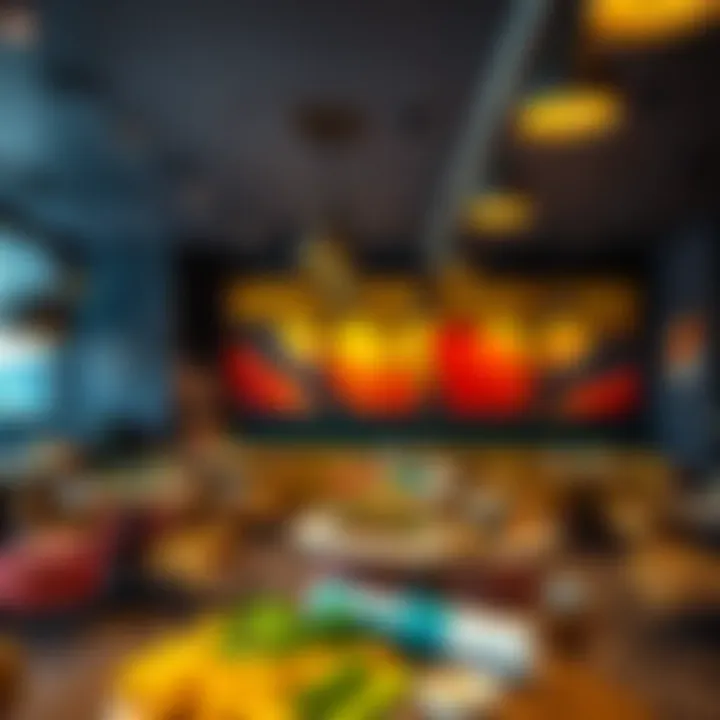
- Local laws: Keeping current with changes in local laws is paramount, as regulations may shift.
- Approval processes: Having a clear understanding of the sequential steps for obtaining required permits is crucial.
"Designing a restaurant isn’t just about making it look good; it's about making it work correctly within the framework of local regulations."
Having a good working relationship with local authorities can also help expedite some processes. Engaging with consultants who are knowledgeable about the local context can pave the way for more efficient design cycles.
By recognizing these challenges and adopting strategic methods to handle them, restaurant interior designers in Dubai can not only sustain their creativity but also ensure their projects unfold smoothly, setting the stage for thriving dining experiences.
The Process of Restaurant Interior Design
Understanding the process of restaurant interior design is essential for anyone interested in creating an inviting and functional space. This process serves as the backbone of any successful restaurant concept, shaping the customer's experience right from the moment they step through the door. By carefully orchestrating each phase, a designer ensures that aesthetics, functionality, and brand identity come together seamlessly.
Initial Consultation and Conceptualization
The journey begins with an initial consultation, where designers gather insights about the restaurant's vision, concept, and target audience. This phase is pivotal for establishing a strong foundation. Here, it’s not just about measuring space or discussing color palettes; it’s about constructing a narrative.
- Defining Goals: Clear objectives are laid out. What emotions should the restaurant evoke? How does it align with the culinary offerings? This initial dialogue can often uncover the essence of the dining experience, guiding every decision that follows.
- Understanding Constraints: Designers take note of any constraints—budget limitations, space restrictions, or regulatory requirements—that might impact the design. In Dubai, where the skyline is as varied as the culinary landscape, those constraints can be as diverse as the clientele.
- Sketching Ideas: Designers often use simple sketches or mood boards to capture the client’s vision. These preliminary visuals pave the way for creative brainstorming, prompting discussions about color schemes, style, and layout.
Design Development and Selection of Materials
Once the concept is set in stone, the focus shifts to design development and selecting materials. This phase is about fleshing out those initial ideas and solidifying the aesthetic direction. A clear vision emerges, detailing everything from the layout to the furniture.
- Space Planning: It's crucial to optimize the space based on the restaurant's flow; creating comfortable seating arrangements while allowing for efficient staff movement. This planning phase can make or break operational efficiency.
- Choosing Materials: Designers draw inspiration from local cultures, current trends, and sustainability to select materials. In Dubai, where luxury meets tradition, choices like marble, wood, or textiles need to resonate with both local and global sensibilities. For instance, combining natural elements with high-tech finishes can create an appealing contrast that tells a story about the restaurant's identity.
- Visual Representation: Utilizing 3D models or renderings aids in visualizing the space. This not only helps in fine-tuning details but also allows stakeholders to visualize how each material will fit into the overall theme.
Implementation and Project Management
After the design is polished, it’s time for implementation and project management. This is where concepts take physical form, and careful oversight is crucial to ensure the design translates effectively in reality.
- Coordinating Contractors: Designers often act as liaisons between clients and contractors to ensure that all aspects of the design are executed as planned. This can involve detailed meetings to discuss timelines, budgets, and quality control—critical factors that influence the final output.
- Quality Assurance: Regular site visits are essential to monitor the progress and make adjustments as needed. The goal is to ensure that nothing is lost in translation—from the ambiance to the smallest detail.
- Final Touches: Once construction wraps up, designers turn their attention to the finishing touches. This involves lighting, art selection, and integrating technology, which can greatly enhance the overall dining experience. An inviting atmosphere is critical for repeat business.
"A well-designed restaurant isn’t just about looks; it’s about creating an experience that engages all the senses."
The process of restaurant interior design in Dubai encapsulates more than just aesthetic choices; it embodies a strategic approach to crafting spaces that foster connection and imbue character into culinary ventures. Through each phase, designers must balance creativity with practicality, ensuring the final product brings the client's vision to life.
Integrating Technology in Restaurant Design
In today’s fast-paced world, the integration of technology into restaurant interior design is more than a trend; it's a necessity. Designers have to blend technology seamlessly into the dining space, enhancing not just the aesthetics but also the functionality. Smart technology can significantly impact both operational efficiency and the customer experience, leading to greater satisfaction and loyalty. This section dives into the critical role technology plays in restaurant design, focusing on dividends it offers and considerations for design teams.
Smart Restaurant Technologies
When it comes to smart restaurant technologies, the possibilities are quite vast. Imagine entering a restaurant where the lighting adjusts according to the time of day, or the heating and cooling systems optimize based on current occupancy. These innovations are not mere fantasies; they are realities in many modern establishments.
Some of the notable technologies include:
- Tabletop Ordering Systems: Using tablets or mobile apps to allow diners to place orders directly from their tables, minimizing wait times and staff interaction.
- Smart Inventory Management: Systems enabled with AI track inventory levels in real-time, automatically reordering supplies before they run out, ensuring that nothing is missed during service.
- Contactless Payment Solutions: With advances in mobile payments, patrons can check out simply by scanning a QR code, streamlining the payment process and reducing cash handling.
Investing in these technologies can lead to a more efficient operation while providing guests with an enhanced experience that keeps them engaged.
Virtual Reality in Design Processes
Virtual reality is reshaping the landscape of restaurant design by allowing designers and clients to visualize concepts in an immersive environment before any physical work begins. This approach tackles one of the common pain points in interior design: the disconnect between vision and reality.
Using VR technology, stakeholders can:
- Walk Through Designs: Experience the proposed design in a fully-scaled 3D environment, identifying potential issues and making adjustments before implementation.
- Engage Layers of Design: Explore different layouts and décor options, providing feedback in real-time, thus fostering collaboration among designers and clients.
- Enhance Client Presentations: Instead of relying on 2D sketches or mood boards, offering clients this immersive experience can help better convey the overall vibe and functionality of the space.
Adopting virtual reality not just saves time but can also save costs, decreasing the likelihood of costly alterations during the construction phase. Plus, it adds a layer of excitement to the design process that can attract investors and stakeholders alike.
"Technology is not just an add-on in design; it is an integral part of shaping the future of dining experiences."
The synergy between technology and design undoubtedly shapes the dynamic restaurant landscape in Dubai today. Both smart technologies and virtual reality stand out as powerful tools that pave the way for innovative, inviting, and efficient dining environments.
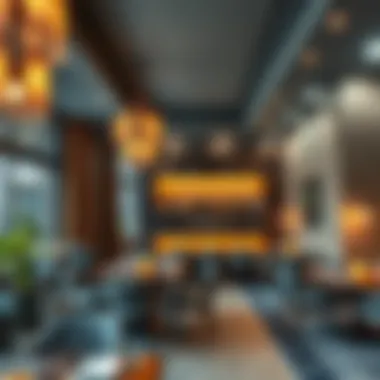
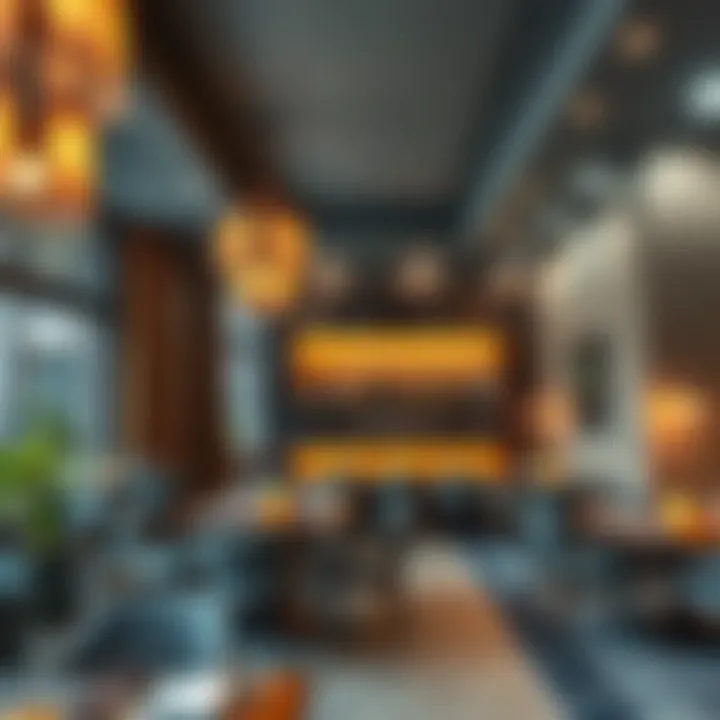
Showcasing Iconic Restaurant Designs
In the fast-paced culinary scene of Dubai, where unique dining experiences are highly sought after, the role of iconic restaurant designs cannot be overstated. These designs serve not only as a feast for the eyes but also as a catalyst for creating memorable moments. From the moment patrons walk in, they are greeted by settings that tell a story, evoke emotions, and, quite frankly, can make or break the dining experience.
The importance of showcasing iconic restaurant designs extends beyond mere aesthetics. Restaurant interior design serves as a silent ambassador of the concept and ethos behind the culinary establishment. An engaging space can forge an emotional connection with diners, influencing their perceptions and driving repeat business. The synergy between food and environment elevates the overall experience, which can often be the tipping point for culinary success. In a city where competition is fierce, having a visually stunning and thoughtfully designed restaurant can drastically improve a brand’s competitive edge.
"The first impression is the last impression," and in the restaurant business, this is as true as it gets.
Case Study: Unique Dining Experiences
To truly grasp the essence of how design plays a pivotal role in dining, one can look at renowned establishments like Al Mahara, located within the luxurious Burj Al Arab. This seafood restaurant is designed to create a unique underwater experience. Patrons dine in a setting that features a mesmerizing aquarium filled with vibrant marine life. The immersive ambiance not only complements the seafood offerings but also enhances the overall sensory experience of dining. Every element, from the seating arrangement to the lighting, works in harmony to create a breathtaking environment that distinguishes it from any other restaurant in Dubai.
Another engaging example is At.mosphere, located on the 122nd floor of the Burj Khalifa. The design expertly balances grandeur with intimacy, featuring floor-to-ceiling windows that offer stunning views of the Dubai skyline. The plush yet elegant decor invites guests to relax while enjoying refined cuisine, all against the backdrop of the world's tallest building. This marriage of location and design creates a memorable dining experience that resonates with visitors and locals alike.
Famous Designers and Their Signature Styles
When it comes to the realm of restaurant design in Dubai, a few names stand out, each bringing their unique flair to the table.
- David Collins Studio is known for its opulent aesthetics and theatrical designs. Their work often combines luxury with intricate details, as seen in The Ivy.
- Concrete is another name that commands attention. Their style embodies simplicity and functionality, showcasing raw materials to create modern and chic settings. They have been involved in various high-profile projects around the city such as Folly by Nick & Scott.
- Zaha Hadid's firm once more left its mark on the culinary landscape with the design of the Opus. The flowing forms are indicative of her distinctive approach that challenges conventional shapes, thus making the restaurant a work of art in itself.
These designers not only highlight the creative potential within interior design but also reflect how pivotal their work is in shaping dining culture in Dubai. The designs they create serve as a backdrop for the stories each restaurant seeks to tell, reinforcing the notion that design is an essential ingredient when it comes to culinary success.
The Future of Restaurant Interior Design in Dubai
The concept of future restaurant interior design in Dubai is an intricately woven tapestry of technological advancements, rising customer expectations, and evolving cultural contexts. This section serves to scrutinize the impending changes that could shape the dining landscape in this vibrant city. In a place where innovation and tradition intermingle, understanding how these elements interact is paramount for investors, real estate agents, and developers who wish to thrive in Dubai's competitive market.
The trends and preferences discussed here are not merely theoretical. They have the potential to redefine how restaurants engage with their patrons. As the foodservice industry continues to grow, the way restaurants are designed becomes a critical factor for success, directly impacting customer experiences and business performance.
Anticipated Trends
In the ever-evolving world of restaurant design, several anticipated trends have begun to emerge and are expected to gain greater traction in the near future:
- Sustainable Design: As environmental awareness rises, restaurants are adopting eco-friendly materials and energy-efficient solutions. Expect a blend of aesthetics and sustainability, where design choices reflect a commitment to the planet. Restitutions of natural materials like reclaimed wood and bamboo are likely to replace traditional furnishings.
- Flexible Spaces: Urban density necessitates multifunctional areas. Expect to see more adaptable designs that transition from casual dining to vibrant events. Restaurant spaces that can easily morph according to specific needs can help optimize profitability.
- Cultural Nuances: With Dubai being a melting pot of cultures, restaurants are increasingly incorporating local art and design elements. Integrating this culture enhances the dining experience, offering guests an authentic taste of Dubai’s heritage.
"Design is the silent ambassador of your brand.” – Paul Rand
- Smart Integration: Technology continues to advance, and with it comes the integration of smart solutions into restaurant designs. Features like automated lighting and temperature controls will not only enhance energy efficiency but also improve the overall guest experience.
- Open Kitchens: Transparency in food preparation is a growing trend. Open kitchens not only engage customers but also allow chefs to showcase their culinary skills, thereby creating a unique dining interaction.
Evolving Consumer Preferences
Recognizing shifting consumer preferences is crucial for anyone involved in restaurant interior design:
- Personalization: Today's diners frequently seek tailored experiences. Restaurants might design spaces that cater to individual preferences, ensuring that every customer feels valued and appreciated.
- Health and Wellness: The health-conscious trend influences not only menus but also design choices. Restaurants may lean toward wellness-oriented environments that promote relaxation and health, utilizing biophilic design principles.
- Experiential Dining: Consumers are after more than just food; they want a whole experience. Designing environments that cater to storytelling and immersive dining experiences may become key differentiators.
- Community-Centric Spaces: There is an increased desire for environments that foster community engagement. This could lead to designs that include communal dining tables or spaces that encourage social interaction.
As Dubai continues to evolve, so too will the expectations of its gastronomic landscape. Fostering an understanding of these trends helps those involved in restaurant interior design not only to survive but thrive, directly contributing to the overall success of dining establishments. By responding proactively to these anticipated changes, stakeholders can ensure they remain ahead of the curve in this fast-paced industry.
For further insights into design and cultural trends, resources like Wikipedia, Britannica, and various local community forums on Reddit can offer valuable perspectives.
Epilogue
When considering the dining landscape in Dubai, the role of restaurant interior design cannot be overstated. This article sheds light on the intricate tapestry of influences, choices, and design philosophies that are shaping the dining experience in one of the world’s most vibrant cities. Successful interior design goes beyond aesthetics; it creates atmospheres that resonate with diners while serving functional needs. Thus, understanding the elements that contribute to a successful design is indispensable for restaurant owners and investors alike.
Summarizing Key Insights
The exploration into Dubai’s restaurant interior design reveals several critical insights:
- Cultural Fusion: Many designs reflect a unique blend of local traditions and modern aesthetics, embodying the city's spirit.
- Consumer Expectations: Today’s diners seek more than just food; they desire an experience, where the ambiance complements their meal.
- Sustainability Concerns: Increased awareness around eco-friendly materials is influencing decisions, attracting a more conscientious clientele.
As a takeaway, understanding the landscape of restaurant interior design in Dubai indicates that a thoughtful approach can create not just a space to eat, but a destination in itself.
The Impact of Restaurant Design on Business Success
Restaurant design intricately ties to business performance in numerous ways. Effective interior design can:
- Enhance Customer Experience: A well-designed environment can create memorable experiences, encouraging repeat visits and word-of-mouth referrals.
- Influence Menu Price: A sophisticated design can justify higher menu prices, as consumers often associate aesthetic quality with premium offerings.
- Shape Brand Identity: Design elements signal to customers what to expect from a brand, ensuring that both atmosphere and service align with the restaurant's philosophy.
A strong restaurant design not only attracts customers but also builds loyalty; it’s an investment in the future of the business.
In light of these factors, it's clear that diving into the world of restaurant design in Dubai presents substantial opportunities for those willing to innovate. It’s about creating spaces that resonate, inspire, and ultimately lead to lasting success.







